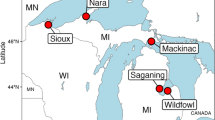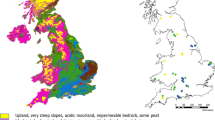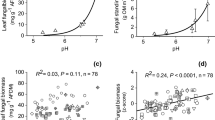Abstract
Many microbes responsible for inorganic nutrient uptake and transformation utilize dissolved organic matter (DOM) as a nutrient or energy source, but little is known about whether DOM composition is an important driver of nutrient uptake in streams. Our goal was to determine whether incorporating DOM composition metrics with other more commonly considered biological, physical, and chemical variables improved our ability to explain patterns of ammonium (\({\text{NH}}_{4}^{ + }\)–N) and soluble reactive phosphorus (SRP) uptake across 11 Lake Superior tributaries. Nutrient uptake velocities (Vf) ranged from undetectable to 14.6 mm min−1 for \({\text{NH}}_{4}^{ + }\)–N and undetectable to 7.2 mm min−1 for SRP. Logistic regressions suggested that DOM composition was a useful predictor of where SRP uptake occurred (4/11 sites) and \({\text{NH}}_{4}^{ + }\)–N concentration was a useful predictor of where \({\text{NH}}_{4}^{ + }\)–N uptake occurred (9/11 sites). Multiple regression analysis revealed that the best models included temperature, specific discharge, and canopy cover, and DOM composition as significant predictors of \({\text{NH}}_{4}^{ + }\)–N Vf. Partial least squares revealed fluorescence index (describing the source of aquatic fulvic acids), specific ultraviolet absorbance at 254 nm (an indicator of DOM aromaticity), temperature, and conductivity were highly influential predictors of \({\text{NH}}_{4}^{ + }\)–N Vf. Therefore, streams with higher temperatures, lower solute concentrations, more terrestrial DOM signal and greater aromaticity had greater \({\text{NH}}_{4}^{ + }\)–N Vf. Our results suggest that DOM composition may be an important, yet often overlooked, predictor of \({\text{NH}}_{4}^{ + }\)–N and SRP uptake in deciduous forest streams that should be considered along with commonly measured predictors.




Similar content being viewed by others
References
Alexander RB, Smith RA, Schwarz GE (2000) Effect of stream channel size on the delivery of nitrogen to the Gulf of Mexico. Nature 403:758–761
Allen NS, Hershey AE (1996) Seasonal changes in chlorophyll a response to nutrient amendments in a north shore tributary of Lake Superior. J N Am Benthol Soc 15:170–178
American Public Health Association (APHA, 2005) Standard methods for the examination of water and wastewater. American Public Health Association
Ankers C, Walling DE, Smith RP (2003) The influence of catchment characteristics on suspended sediment properties. Hydrobiologia 494:159–167
Bechtold HA, Marcarelli AM, Baxter CV, Inouye RS (2012) Effects of N, P, and organic carbon on stream biofilm nutrient limitation and uptake in a semi-arid watershed. Limnol Oceanogr 57:1544–1554. doi:10.4319/lo.2012.57.5.1544
Belmont P, Morris DP, Pazzaglia FJ, Peters SC (2009) Penetration of ultraviolet radiation in streams of eastern Pennsylvania: topographic controls and the role of suspended particulates. Aquat Sci 71:189–201. doi:10.1007/s0027-009-91-20-7
Benner R (2003) Molecular indicators of the bioavailability of dissolved organic matter. In: Findlay SE, Sinsabaugh RL (eds) Aquatic ecosystems interactivity of dissolved organic matter. Academic, San Diego, pp 121–137
Bergey EA, Getty GM (2006) A review of methods for measuring the surface area of stream substrates. Hydrobiologia 556:7–16. doi:10.1007/s10750-005-1042-3
Bernhardt ES, Likens GE (2002) Dissolved organic carbon enrichment alters nitrogen dynamics in a forest stream. Ecology 83:1689–1700
Biddanda BA, Cotner JB (2002) Love handles in aquatic ecosystems: the role of dissolved organic carbon drawdown, resuspended sediments, and terrigenous inputs in the carbon balance of Lake Michigan. Ecosystems 5:431–445
Burnham KP, Anderson DR (2002) Model selection and multimodel inference: a practical information-theoretic approach, 2nd edn. Springer, New York
Butturini A, Sabater F (1998) Ammonium and phosphate retention in a Mediterranean stream: hydrological versus temperature control. Can J Fish Aquat Sci 55:1938–1945
Carrascal LM, Galvan I, Gordo O (2009) Partial least squares regression as an alternative to current regression methods used in ecology. Oikos 118:681–690. doi:10.1111/j.1600-0706.2008.16881.x
Coble AA, Marcarelli AM, Kane ES (2015) Ammonium and glucose amendments stimulate dissolved organic matter mineralization in a Lake Superior tributary. J Gt Lakes Res 41:801–807. doi:10.1016/j.jglr.2015.05.015
Coble AA, Marcarelli AM, Kane ES, Toczydlowski D, Stottlemyer R (2016) Temporal patterns of dissolved organic matter biodegradability are similar across three rivers of varying size. J Geophys Res Biogeosci. doi:10.1002/2015JG003218
Cory RM, Mcknight DM (2005) Fluorescence spectroscopy reveals ubiquitous presence of oxidized and reduced quinones in dissolved organic matter. Environ Sci Technol 39:8142–8149
Dalzell BJ, King JY, Mulla DJ, Finley JC, Sands GR (2011) Influence of subsurface drainage on quantity and quality of dissolved organic matter export from agricultural landscapes. J Geophys Res 116:G02023. doi:10.1029/2010JG001540
Davis JC, Minshall GW (1999) Nitrogen and phosphorus uptake in two Idaho (USA) headwater wilderness streams. Oecologia 119:247–255
Ensign SC, Doyle MW (2006) Nutrient spiraling in streams and river networks. J Geophys Res 111:G04009. doi:10.1029/2005JG000114
Frost PC, Larson JH, Johnston CA, Young KC, Maurice PA, Lamberti GA, Bridgham SD (2006) Landscape predictors of stream dissolved organic matter concentration and physicochemistry in a Lake Superior river watershed. Aquat Sci 68:40–51. doi:10.1007/s00027-005-0802-5
Geeraert N, Omengo FO, Gover G, Bouillon S (2016) Dissolved organic carbon lability and stable isotope shifts during microbial decomposition in a tropical river system. Biogeosciences 13:517–525. doi:10.5194/bg-13-517-2016
Gergel SE, Turner MG, Kratz TK (1999) Dissolved organic carbon as an indicator of the scale of watershed influence on lakes and rivers. Ecol Appl 9:1377–1390
Ghosh S, Leff LG (2013) Impacts of labile organic carbon concentration on organic and inorganic nitrogen utilization by a stream biofilm bacterial community. Appl Environ Microbiol 79:7130–7141. doi:10.1128/AEM.01694-13
Gough MA, Mantoura RRC, Preston M (1993) Terrestrial plant biopolymers in marine sediments. Geochim Cosmochim Acta 57:945–964
Hall RO, Tank JL (2003) Ecosystem metabolism controls nitrogen uptake in streams in Grand Teton National Park, Wyoming. Limnol Oceanogr 48:1120–1128
Hall RO, Bernhardt ES, Likens GE (2002) Relating nutrient uptake with transient storage in forested mountain streams. Limnol Oceanogr 47:255–265
Hedges JI, Blanchette RA, Weliky K, Devol AH (1988) Effects of fungal degradation on the CuO oxidation products of lignin: a controlled laboratory study. Geochim Cosmochim Acta 52:2717–2726. doi:10.1016/0016-7037(88)90040-3
Helms JR, Stubbins A, Perdue EM, Green NW, Chen H, Mopper K (2013) Photochemical bleaching of oceanic dissolved organic matter and its effect on absorption spectral slope and fluorescence. Mar Chem 155:81–91. doi:10.1016/j.marchem.2013.05.015
Hill BH, Elonen CM, Jicha TM, Cotter AM, Trebitz AS, Danz NP (2006) Sediment microbial enzyme activity as an indicator of nutrient limitation in Great Lakes coastal wetlands. Freshw Biol 51:1670–1683. doi:10.111/j.1365-2427.2006.01606.x
Hill BH, Elonen CM, Jicha TM, Bolgrien DW, Moffett MF (2010) Sediment microbial enzyme activity as an indicator of nutrient limitation in the great rivers of the Upper Mississippi River Basin. Biogeochemistry 97:195–209. doi:10.1007/s10533-009-9366-0
Hoellein TJ, Tank JL, Rosi-Marshall EJ, Entrekin SA, Lamberti GA (2007) Controls on spatial and temporal variation of nutrient uptake in three Michigan headwater streams. Limnol Oceanogr 52:1964–1977
Holmes RM, Aminot A, Kérouel R, Hooker BA, Peterson BJ (1999) A simple and precise method for measuring ammonium in marine and freshwater ecosystems. Can J Fish Aquat Sci 56:1801–1808
Holmes RM, McClelland JW, Raymond PA, Frazer BB, Peterson BJ, Stieglitz M (2008) Lability of DOC transported by Alaskan rivers to the Arctic Ocean. Geophys Res Lett 35:L03402. doi:10.1029/2007GL032837
Hood E, Gooseff MN, Johnson SL (2006) Changes in the character of stream water dissolved organic carbon during flushing in three small watersheds, Oregon. J Geophys Res 111:G01007. doi:10.1029/2005JG000082
Johnson LT, Tank JL, Arango CP (2009) The effect of land use on dissolved organic carbon and nitrogen uptake in streams. Freshw Biol 54:2335–2350. doi:10.1111/j.1365-2427.2009.02261.x
Johnson LT, Royer TV, Edgerton JM, Leff LG (2012) Manipulation of the dissolved organic carbon pool in an agricultural stream: responses in microbial community structure, denitrification, and assimilatory nitrogen uptake. Ecosystems 15:1027–1038. doi:10.1007/s10021-012-9563-x
Kalbitz K, Wennrich R (1998) Mobilization of heavy metals and arsenic in polluted wetland soils and its dependence on dissolved organic matter. Sci Total Environ 209:27–39. doi:10.1016/S0048-9697(97)00302-1
Kaplan LA, Newbold JD (2003) The role of monomers in stream ecosystem metabolism. In: Findlay SE, Sinsabaugh RL (eds) Aquatic ecosystems interactivity of dissolved organic matter. Academic, San Diego, pp 97–120
Kirchman DL, Rich JH (1997) Regulation of bacterial growth rates by dissolved organic carbon and temperature in the equatorial Pacific Ocean. Microb Ecol 33:11–20
Kostoglidis A, Pattiaratchi CB, Hamilton DP (2005) CDOM and its contribution to the underwater light climate of a shallow microtidal estuary in south-wester Australia. Estuar Coast Shelf Sci 63:469–477
Kothawala DN, Stedmon CA, Müller RA, Weyhenmeyer GA, Köhler SJ, Tranvik LJ (2014) Controls of dissolved organic matter quality: evidence from a large-scale boreal lake survey. Glob Change Biol 20:1101–1114. doi:10.1111/gcb.12488
Kruckeberg AR (2002) Geology and plant life: the effects of landforms and rock types on plants. University of Washington Press, Seattle
Larson JH, Frost PC, Xenopoulos MA, Williams CJ, Morales-Williams AM, Vallazza JM, Nelson JC, Richardson WB (2014) Relationships between land cover and dissolved organic matter change along the river to lake transition. Ecosystems 17:1413–1425. doi:10.1007/s10021-014-9804-2
Lehto LL, Hill BH (2013) The effect of catchment urbanization on nutrient uptake and biofilm enzyme activity in Lake Superior (USA) tributary streams. Hydrobiologia 713:35–51. doi:10.1007/s10750-013-1491-z
Lennon JT, Pfaff LE (2005) Source and supply of terrestrial organic matter affects aquatic microbial metabolism. Aquat Microb Ecol 39:107–119. doi:10.3354/ame039107
Logvinova CL, Frey KE, Mann PJ, Stubbins A, Spencer RGM (2015) Assessing the potential impacts of declining Arctic Sea ice cover on the photochemical degradation of dissolved organic matter in the Chukchi and Beaufort Seas. J Geophys Res Biogeosci 120:2326–2344. doi:10.1002/2015JG003052
Maranger R, Pullen MJ (2003) Elemental complexation by dissolved organic matter in lakes: implications for Fe speciation and the bioavailability of Fe and P. In: Findlay SE, Sinsabaugh RL (eds) Aquatic ecosystems interactivity of dissolved organic matter. Academic, New York, pp 186–214
Marín-Spiotta E, Gruley KE, Crawford J, Atkinson EE, Miesel JR, Greene S, Cardona-Correa C, Spencer RGM (2014) Paradigm shifts in soil organic matter research affect interpretations of aquatic carbon cycling: transcending disciplinary and ecosystem boundaries. Biogeochemistry 117:270–297. doi:10.1007/s10533-013-9949-7
Marschner B, Kalbitz K (2003) Controls of bioavailability and biodegradability of dissolved organic matter in soils. Geoderma 113:211–235
Marti EJ, Sabater F (1996) High variability in temporal and spatial nutrient retention in Mediterranean streams. Ecology 77(3):854–869
Marti E, Aumatell J, Godé L, Poch M, Sabater F (2004) Nutrient retention efficiency in streams receiving inputs from wastewater treatment plants. J Environ Qual 33:285–293
McCallister SL, del Giorgio PA (2012) Evidence for the respiration of ancient terrestrial organic C in northern temperate lakes and streams. Proc Natl Acad Sci USA 109:16963–16968
McKnight DM, Boyer EW, Westerhoff PK, Doran PT, Kulbe T, Anderson DT (2001) Spectrofluorometric characterization of dissolved organic matter for indication of precursor organic material and aromaticity. Limnol Oceanogr 46:38–48. doi:10.4319/lo.2001.46.1.0038
McKnight DM, Hood E, Klapper L (2003) Trace organic moieties of dissolved organic material in natural waters. In: Findlay SE, Sinsabaugh RL (eds) Aquatic ecosystems interactivity of dissolved organic matter. Academic, San Diego, pp 71–96
Michigan Department of Environmental Quality (MDEQ) Geologic Survey Division (1987) Template—bedrock geology. MDEQ, Lansing
Mulholland PJ (1992) Regulation of nutrient concentrations in a temperate forest stream: roles of upland, riparian, and instream processes. Limnol Oceanogr 37:1512–1526
Mulholland PJ, Steinman AD, Elwood JW (1990) Measurement of phosphorus uptake length in streams: comparison of radiotracer and stable PO4 releases. Can J Fish Aquat Sci 47:2351–2357
Mulholland PJ, Tank JL, Webster JR et al (2002) Can uptake length in streams be determined by nutrient addition experiments? Results from an interbiome comparison study. J N Am Benthol Soc 21:544–560
Nusch EA (1980) Comparison of different methods for chlorophyll and phaeopigment determination. Arch Hydrobiol 14:14–36
Opsahl S, Benner R (1998) Photochemical reactivity of dissolved lignin in river and ocean waters. Limnol Oceanogr 43:1297–1304
Oviedo-Vargas D, Royer TV, Johnson LT (2013) Dissolved organic carbon manipulation reveals coupled cycling of carbon, nitrogen, and phosphorus in a nitrogen-rich stream. Limnol Oceanogr 58:1196–1206. doi:10.4319/lo.2013.58.4.1196
Payn RA, Webster JR, Mulholland PJ, Valett HM, Dodds WK (2005) Estimation of stream nutrient uptake from nutrient addition experiments. Limnol Oceanogr Methods 3:174–182
Peterson BJ, Wollheim WM, Mulholland PJ et al (2001) Control of nitrogen export from watersheds by headwater streams. Science 292:86–90
Pomeroy LR, Wiebe WJ (2001) Temperature and substrates as interactive limiting factors for marine heterotrophic bacteria. Aquat Microb Ecol 2:187–204
Prairie YT (2008) Carbocentric limnology: looking back, looking forward. Can J Fish Aquat Sci 65:543–548
Reed HE, Martiny JBH (2007) Testing the functional significance of microbial composition in natural communities. FEMS Microbiol Ecol 62:161–170
Reynolds M (1995) Geology of Tenderfoot Creek Experimental Forest, Little Belt Mountains, Meagher County, Montana. In: Farnes P (ed) Hydrologic and geologic characteristics of Tenderfoot Creek Experimental Forest, Montana. Final Report, RJVA-INT-782 92734. Intermountain Research Station Forest Service, US Department of Agriculture, Bozeman
Runkel RL (2015) On the use of rhodamine WT for the characterization of stream hydrodynamics and transient storage. Water Resour Res 51:6125–6142. doi:10.1002/2015WR017201
Sabater F, Butturini A, Martí E, Muñoz I, Romaní A, Wray J, Sabater S (2000) Effects of riparian vegetation removal on nutrient retention in a Mediterranean stream. J N Am Benthol Soc 19:609–620
Schlesinger WH, Cole JJ, Finzi AC, Holland EA (2011) Introduction to coupled biogeochemical cycles. Front Ecol Environ 9:5–8. doi:10.1890/090235
Schmidt MWI, Torn MS, Abiven S, Dittmar T, Guggenberger G, Janssens IA, Kleber M, Kogel-Knabner I, Lehmann J, Manning DAC, Nannipieri P, Rasse DP, Weiner S, Trumbore SE (2011) Persistence of soil organic matter as an ecosystem property. Nature 478:49–56. doi:10.1038/nature10386
Simon KS, Townsend CR, Biggs BJF (2005) Temporal variation of N and P uptake in 2 New Zealand streams. J N Am Benthol Soc 24(1):1–18
Sobczak WV, Findlay S, Dye S (2003) Relationships between DOC bioavailability and nitrate removal in an upland stream: an experimental approach. Biogeochemistry 62:309–327
Spencer RGM, Aiken GR, Wickland KP, Striegl RG, Hernes PJ (2008) Seasonal and spatial variability in dissolved organic matter quantity and composition from the Yukon River Basin, Alaska. Glob Biogeochem Cycles 22:GB4002. doi:10.1029/2008GB003231
Stedmon CA, Bro R (2008) Characterizing dissolved organic matter fluorescence with parallel factor analysis: a tutorial. Limnol Oceanogr Methods 6:572–579. doi:10.4319/lom.2008.6.572
Stedmon CA, Markager S, Bro R (2003) Tracing dissolved organic matter in aquatic environments using a new approach to fluorescence spectroscopy. Mar Chem 82:239–254. doi:10.1016/S0304-4203(03)00072-0
Sterner RW, Elser JJ (2002) Ecological stoichiometry. Princeton University Press, Princeton
Sterner RW, Smutka TM, McKay RML, Xiaoming Q, Brown ET, Sherrell RM (2004) Phosphorus and trace metal limitation of algae and bacteria in Lake Superior. Limnol Oceanogr 49:495–507
Stottlemyer R (1997) Streamwater chemistry in watersheds receiving different atmospheric inputs of H+, NH4 +, NO3 −, and SO4 2−. J Am Water Resour Assoc 33:767–780
Stottlemyer R, Toczydlowski D (2006) Effect of reduced winter precipitation and increased temperature on watershed solute flux. Biogeochemistry 77:409–440. doi:10.1007/s10533-005-1810-1
Stream Solute Workshop (1990) Concepts and methods for assessing solute dynamics in stream ecosystems. J N Am Benthol Soc 9:95–119
Taylor BW, Keep CF, Hall RO Jr et al (2007) Improving the fluorometric ammonium method: matrix effects, background fluorescence, and standard additions. J N Am Benthol Soc 26:167–177
Thurman M (ed) (1985) Organic geochemistry of natural waters, vol 2. Springer, Dordrecht
Toming K, Tuvikene L, Vilbaste S, Agaslid H, Viik M, Kisan A, Feldmann T, Martma T, Jones R, Nõges T (2013) Contributions of autochthonous and allochthonous sources to dissolved organic matter in a large, shallow eutrophic lake with a highly calcareous catchment. Limnol Oceanogr 58:1259–1270. doi:10.4319/lo.2013.58.4.1259
Tranvik LJ, von Wachenfeldt E (2009) Interactions of dissolved organic matter and humic substances. In: Likens GE (ed) Biogeochemistry of inland waters a derivative of encyclopedia of inland waters. Academic, San Diego, pp 464–470
Triska FJ, Jackman AP, Duff JH, Avanzino RJ (1994) Ammonium sorption to channel and riparian sediments: a transient storage pool for dissolved inorganic nitrogen. Biogeochemistry 26:67–83
von Schiller D, Bernal S, Sabater F, Martí E (2015) A round-trip ticket: the importance of release processes for in-stream nutrient spiralling. Freshw Sci 34:20–30. doi:10.1086/679015
Ward ND, Keil RG, Medeiros PM, Brito DC, Cunha AC, Dittmar T, Yager PL, Krusche AV, Richey JE (2013) Degradation of terrestrially derived macromolecules in the Amazon River. Nat Geosci 6:530–533
Webster KE, Soranno PA, Cheruvelil KS et al (2008) An empirical evaluation of the nutrient-color paradigm for lakes. Limnol Oceanogr 53:1137–1148
Weishaar JL, Aiken GR, Bergamaschi BA, Fram MS, Fujii R, Mopper K (2003) Evaluation of specific ultraviolet absorbance as an indicator of the chemical composition and reactivity of dissolved organic carbon. Environ Sci Technol 37:4702–4708
Wickland KP, Aiken GR, Butler K, Dornblaser MM, Spencer RGM, Striegl RG (2012) Biodegradability of dissolved organic carbon in the Yukon River and its tributaries: seasonality and importance of inorganic nitrogen. Glob Biogeochem Cycles 26:GB0E03. doi:10.1029/2012GB004342
Williams CJ, Scott AB, Wilson HF, Xenopoulos MA (2012) Effects of land use on water column bacterial activity and enzyme stoichiometry in stream ecosystems. Aquat Sci 74:483–494. doi:10.1007/s00027-011-0242-3
Williamson CE, Dodds W, Kratz TK, Palmer MA (2008) Lakes and streams as sentinels of environmental change in terrestrial and atmospheric processes. Front Ecol Environ 6:247–254. doi:10.1890/070140
Withers PJA, Jarvie HP (2008) Delivery and cycling of phosphorus in rivers: a review. Sci Total Environ 400:379–395
Wold AP, Hershey AE (1999) Spatial and temporal variability of nutrient limitation in 6 north shore tributaries to Lake Superior. J N Am Benthol Soc 18:2–14
Yamashita Y, Kloeppel BD, Knoepp J, Zausen GL, Jaffé R (2011) Effects of watershed history on dissolved organic matter characteristics in headwater streams. Ecosystems 14:1110–1122. doi:10.1007/s10021-011-9469-z
Acknowledgements
We thank B. Borowitz, A. P. Coble, E. Collins, J. Eikenberry, K. Heiden, J. Kiiskila, T. Matthys, K. Meingast, J. Olson, J. Ortiz, R. Van Goethem, and T. Veverica for field and laboratory assistance. We also thank Dr. V. Webster, Dr. M. Mineau, and four anonymous reviewers for providing comments which greatly improved this manuscript. This research was funded by Huron Mountain Wildlife Foundation, Michigan Technological University’s Research Excellence Fund, the USDA McIntire–Stennis Fund, the University of Michigan Water Center with funds from the Fred A. and Barbara M. Erb Family Foundation, and NASA Michigan Space Grant Consortium. A.A.C. was also supported by a Fellowship from Michigan Technological University’s GK12 Global Watershed Program, funded by National Science Foundation Award DGE-0841073. This is Contribution No. 43 of the Great Lakes Research Center at Michigan Tech.
Author information
Authors and Affiliations
Corresponding author
Additional information
Responsible Editor: J. M. Melack.
Electronic supplementary material
Below is the link to the electronic supplementary material.
Rights and permissions
About this article
Cite this article
Coble, A.A., Marcarelli, A.M., Kane, E.S. et al. Uptake of ammonium and soluble reactive phosphorus in forested streams: influence of dissolved organic matter composition. Biogeochemistry 131, 355–372 (2016). https://doi.org/10.1007/s10533-016-0284-7
Received:
Accepted:
Published:
Issue Date:
DOI: https://doi.org/10.1007/s10533-016-0284-7




